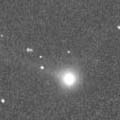
|
It had been observed while brightening rapidly until the perihelion passage on Apr. 19, although it located extremely low in the evening sky. It reached to 6.7 mag on Apr. 17 (Juan Jose Gonzalez). However, it is not observable now. In the Southern Hemisphere, it appears in the morning sky at 8 mag in mid May, then it will be bright and observable for a while. In the Northern Hemisphere, it appears in the morning sky at 12 mag in June. But it locates only 20 degree high at most, and it will be fading rapidly.
Date(TT) R.A. (2000) Decl. Delta r Elong. m1 Best Time(A, h)
Apr. 21 2 57.91 15 13.7 0.767 0.342 16 6.5 20:06 (112, -4)
Apr. 28 2 41.42 8 39.3 0.609 0.411 7 6.5 20:14 (115,-19)
|
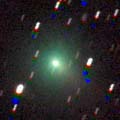
|
New comet discovered in March in the Southern Hemisphere, but it is moving northwards very fast. It appeared in the morning sky also in the Northern Hemisphere in early April, and it is already observable in the excellent condition now. Now it is passing near by the earth, and reached to 7.5 mag (Apr. 22, Juan Jose Gonzalez). It will be observable in good condition at 7-8 mag until mid May. Then it keeps observable until it fades out in the Northern Hemisphere. It will be visible visually until July.
Date(TT) R.A. (2000) Decl. Delta r Elong. m1 Best Time(A, h)
Apr. 21 19 16.98 1 44.1 0.458 1.164 98 7.6 3:51 (322, 50)
Apr. 28 18 38.37 25 59.8 0.450 1.208 105 7.7 3:41 (318, 77)
|
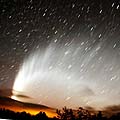
|
Excellent great comet, few times in a lifetime, for southern people. It reached to -5.5 mag on Jan. 14 and 15, brighter than Venus, and visible even in daytime. Then it appeared in the evening sky in the Southern Hemisphere and many people enjoyed a fantastic view of a beautiful great comet, a enormous curving tail with so many striae over 50 degrees. Now it is observable both in the evening and morning. It has already faded down to 9.6 mag (Apr. 19, Stuart Rae). In the Southern Hemisphere, It keeps observable almost all night until the comet has gone. It will never be observable again in the Northern Hemisphere.
Date(TT) R.A. (2000) Decl. Delta r Elong. m1 Best Time(A, h)
Apr. 21 0 45.37 -77 3.5 1.953 2.184 89 9.5 3:51 (344,-37)
Apr. 28 1 21.21 -79 24.4 1.997 2.293 93 9.9 3:41 (347,-38)
|
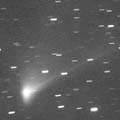
|
The condition was too bad to observe on the earth before the perihelion passage, but it was visible in the SWAN images in mid March, and in the LASCO images in early April. After the perihelion passage on Apr. 4, it appeared in the morning sky. It was so bright as 5.5 mag on Apr. 10 (Michael Jager and Gerald Rhemann), and still bright as 8.8 mag on Apr. 22 (Juan Jose Gonzalez). The condition will get better rapidly after this. However, the comet will fade out rapidly. It will be fainter than 14 mag in mid May, too faint to see visually.
Date(TT) R.A. (2000) Decl. Delta r Elong. m1 Best Time(A, h)
Apr. 21 23 29.02 22 10.9 0.789 0.591 35 9.7 3:51 (253, 15)
Apr. 28 22 55.26 22 1.2 0.744 0.765 49 11.1 3:41 (260, 26)
|
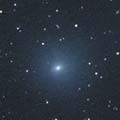
|
Although it was so faint as 13.8 mag in March (Mar. 17, Alan Hale), it brightened very rapidly in early April, and it reached to 8.7 mag on Apr. 10 (Werner hasubick). It is still bright as 9.5 mag now (Apr. 17, Juan Jose Gonzalez). However, the comet is very large, extremely diffuse. It is hard to observe without clear skies. It still locates high in the evening now. However, it will be fading, and getting lower rapidly after this. It will be unobservable in late May.
Date(TT) R.A. (2000) Decl. Delta r Elong. m1 Best Time(A, h)
Apr. 21 8 47.33 13 57.0 0.782 1.376 100 9.9 20:06 ( 45, 63)
Apr. 28 8 15.70 17 31.2 0.982 1.343 84 10.2 20:14 ( 71, 54)
|

|
In this season, it has been bright as 12-13 mag and visible visually since it appeared in the morning sky in early July. It is visible visually as 12.5 mag still now (Apr. 12, Vitali Nevski). However, it is already getting lower in the evening sky, and it will be unobservable soon.
Date(TT) R.A. (2000) Decl. Delta r Elong. m1 Best Time(A, h)
Apr. 21 4 23.64 28 44.7 6.650 5.902 38 13.9 20:06 (112, 20)
Apr. 28 4 29.35 28 50.3 6.717 5.905 33 13.9 20:14 (115, 14)
|
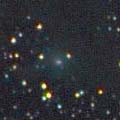
|
It became brighter than expected, and now it is visible visually at 13.4 mag (Apr. 12, Vitali Nevski). However, it is getting lower gradually in the evening sky, and it will be too low to observe in early June. It is not observable around the perihelion passage in July in conjunction with the sun. Then it moves to the southern sky, and it will be unobservable in the Northern Hemisphere.
Date(TT) R.A. (2000) Decl. Delta r Elong. m1 Best Time(A, h)
Apr. 21 5 14.96 38 30.9 2.606 2.142 52 14.0 20:06 (116, 34)
Apr. 28 5 32.86 37 21.9 2.619 2.097 48 13.9 20:14 (117, 30)
|
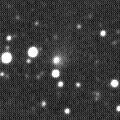
|
Now it is 12.6 mag (Mar. 9, Edwin van Dijk). It has been 12 mag for half a year since last June. But it will start fading after this. It will be too faint to see visually soon. However, the fading is slow. The comet will be fainter than 18 mag in 2008. In the Northern Hemisphere, it keeps observable until that time. In the Northern Hemisphere, it keeps observable all night for a while after this.
Date(TT) R.A. (2000) Decl. Delta r Elong. m1 Best Time(A, h)
Apr. 21 1 34.29 71 18.1 3.046 2.684 59 14.2 3:51 (198, 25)
Apr. 28 2 9.44 70 45.0 3.155 2.737 56 14.4 3:41 (198, 24)
|
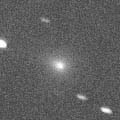
|
First return of a new bright periodic comet observed at 9 mag in 2001. It brightened rapidly also in this return. It was 16.1 mag on Jan. 11 (Filip Fratev), but it brightened up to 11.1 mag on Mar. 11 (Reinder J. Bouma). Unexpectedly, it became as bright as at the discovery, and visible visually. However, the condition of this apparition is bad. It keeps locating very low in the evening until early May. Few observations were reported recently. It must be already very faint.
Date(TT) R.A. (2000) Decl. Delta r Elong. m1 Best Time(A, h)
Apr. 21 4 33.60 13 18.5 1.830 1.227 39 14.4 20:06 ( 97, 14)
Apr. 28 5 2.15 13 44.4 1.897 1.289 39 15.1 20:14 ( 98, 13)
|
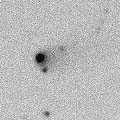
|
It has been visible at 13.5 mag for a long time since 2005 autumn until 2006 spring. Now it is fainter than last year by 1 mag, however, it is still visible visually at 14.2 mag (Dec. 22, Seiichi Yoshida). It keeps observable in excellent condition until May.
Date(TT) R.A. (2000) Decl. Delta r Elong. m1 Best Time(A, h)
Apr. 21 12 47.09 23 38.8 5.083 5.899 141 14.7 22:50 ( 0, 79)
Apr. 28 12 44.34 23 18.1 5.157 5.924 136 14.8 22:19 ( 0, 78)
|
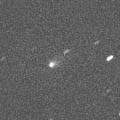
|
It is observable in good condition in the Southern Hemisphere, although it is already not observable in the Northern Hemisphere. It has been 13-14 mag for a long time since last autumn. It is 12.5 mag visually, much brighter than this ephemeris (Apr. 17, Michael Mattiazzo). However, it will be fading gradually after this.
Date(TT) R.A. (2000) Decl. Delta r Elong. m1 Best Time(A, h)
Apr. 21 16 34.07 -74 26.3 1.978 2.548 113 14.8 2:41 ( 0,-19)
Apr. 28 16 25.72 -74 31.7 1.983 2.598 116 14.9 2:05 ( 0,-20)
|
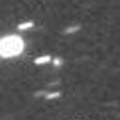
|
Now it is 15.2 mag (Feb. 24, Ken-ichi Kadota). Although it had been unobservable since last autumn, now it is appearing again in the morning sky. It will be observable at 14.5 mag from spring to summer both in 2007 and 2008. The condition is good, and it may be visible visually.
Date(TT) R.A. (2000) Decl. Delta r Elong. m1 Best Time(A, h)
Apr. 21 18 51.42 -9 20.2 5.554 5.924 106 15.0 3:51 (337, 43)
Apr. 28 18 47.36 -8 40.3 5.422 5.908 114 15.0 3:41 (344, 45)
|

|
Getting higher in the morning sky. Now it is 16 mag (Mar. 23, Maciej Reszelski). It will brighten rapidly after this, and reach to 9.5 mag in July. However, it moves southwards very fast in August. It is only observable until mid August in the Northern Hemisphere. On the other hand, it keeps low and hard to observe until mid July in the Southern Hemisphere.
Date(TT) R.A. (2000) Decl. Delta r Elong. m1 Best Time(A, h)
Apr. 21 23 13.70 30 39.7 2.668 2.028 41 15.4 3:51 (248, 23)
Apr. 28 23 16.34 31 50.2 2.513 1.943 45 15.1 3:41 (248, 26)
|
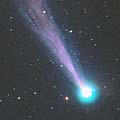
|
It reached up to 4 mag in 2006 autumn. But it had faded down to 10.5 mag on Jan. 11 (Carlos Labordena). It had been unobservable for a long time since that, but now it is appearing at dawn again. After this, it keeps observable until it becomes fainter than 18 mag in autumn.
Date(TT) R.A. (2000) Decl. Delta r Elong. m1 Best Time(A, h)
Apr. 21 22 54.68 -9 52.9 3.778 3.215 49 15.2 3:51 (285, 5)
Apr. 28 22 58.03 -10 20.9 3.760 3.297 55 15.3 3:41 (288, 7)
|
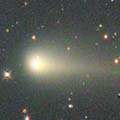
|
It reached up to 9.3 mag between October and November (Oct. 27, Juan Jose Gonzalez). It kept bright and observed visually for a long time, however, it has faded down to 13.0 mag on Mar. 11 (Reinder J. Bouma). It is already too faint to see visually. It will be too low to observe in late May.
Date(TT) R.A. (2000) Decl. Delta r Elong. m1 Best Time(A, h)
Apr. 21 6 13.15 15 25.0 2.502 2.235 63 15.4 20:06 ( 84, 35)
Apr. 28 6 27.27 15 32.2 2.611 2.275 59 15.7 20:14 ( 88, 31)
|
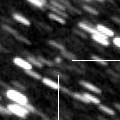
|
It brightened up to 17.5 mag in 2006 autumn, then it became unobservable. But now it is appearing in the morning sky again. It will reach to 14.5 mag in 2007 summer. However, it moves in the southen sky. In the Northern Hemisphere, it rises up to 20 degree at best in May, then it becomes unobservable in July.
Date(TT) R.A. (2000) Decl. Delta r Elong. m1 Best Time(A, h)
Apr. 21 20 54.40 -22 48.2 3.850 3.821 80 15.7 3:51 (315, 17)
Apr. 28 20 55.80 -24 5.3 3.691 3.786 87 15.6 3:41 (319, 18)
|
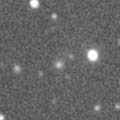
|
Now it brightened up to 15.8 mag (Mar. 11, Ken-ichi Kadota). It keeps 15.5-16 mag for one year and a half after this until 2008 summer. However, because the comet moves southwards, it is only observable until 2007 June in the Northern Hemisphere.
Date(TT) R.A. (2000) Decl. Delta r Elong. m1 Best Time(A, h)
Apr. 21 10 14.03 0 24.6 2.821 3.487 124 15.9 20:17 ( 0, 55)
Apr. 28 10 12.59 -0 1.5 2.863 3.444 117 15.9 20:14 ( 11, 54)
|
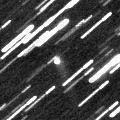
|
Finally it has passed the perihelion, keeping almost asteroidal. It did not brighten at all since early September, and finally it reached to 14 mag at best. It kept locating in good condition, and being observed at 14 mag for a long time in the Northern Hemisphere. However, it has already started fading rapidly since March. It will be getting lower after this, and will be too low in the evening sky at 17 mag in June.
Date(TT) R.A. (2000) Decl. Delta r Elong. m1 Best Time(A, h)
Apr. 21 7 25.74 13 36.7 1.794 1.910 80 15.9 20:06 ( 68, 49)
Apr. 28 7 39.91 11 54.5 1.929 1.976 77 16.1 20:14 ( 71, 44)
|

|
Now it is 16.8 mag (Mar. 25, Ken-ichi Kadota). It is outside of Jupiter's orbit. So it keeps 17 mag for a long time until 2007 summer. It keeps locating high and observable in good condition for a long time after this because it moves in the northern sky.
Date(TT) R.A. (2000) Decl. Delta r Elong. m1 Best Time(A, h)
Apr. 21 14 14.62 40 32.9 6.703 7.359 127 16.7 0:21 (180, 84)
Apr. 28 14 9.56 40 15.6 6.742 7.376 125 16.7 23:44 (180, 85)
|
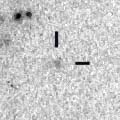
|
Now it is 17.7 mag (Mar. 12, Ken-ichi Kadota). It keeps 17 mag until July when it starts getting lower in the evening sky. It will be observable again at 18 mag in 2008.
Date(TT) R.A. (2000) Decl. Delta r Elong. m1 Best Time(A, h)
Apr. 21 13 57.35 -12 17.7 3.727 4.732 178 17.1 0:04 ( 0, 43)
Apr. 28 13 53.80 -12 2.9 3.733 4.734 173 17.1 23:29 ( 0, 43)
|
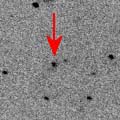
|
It was observed as 17 mag in 2006 summer. Now it is getting higher again in the morning sky. It will be observable at 16.5-17 mag in good condition in 2007 summer.
Date(TT) R.A. (2000) Decl. Delta r Elong. m1 Best Time(A, h)
Apr. 21 21 6.97 5 5.3 6.135 5.884 70 17.1 3:51 (291, 35)
Apr. 28 21 6.39 6 7.0 6.019 5.879 77 17.1 3:41 (293, 39)
|
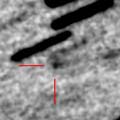
|
Now it is 17.3 mag (Mar. 11, Ken-ichi Kadota). It keeps 17 mag until May, then it will be lower in the evening sky while fading in June.
Date(TT) R.A. (2000) Decl. Delta r Elong. m1 Best Time(A, h)
Apr. 21 10 40.04 8 12.3 1.478 2.242 128 17.1 20:43 ( 0, 63)
Apr. 28 10 42.05 8 10.9 1.530 2.230 121 17.1 20:18 ( 0, 63)
|

|
It will reach to 12 mag in 2008 summer. In the Northern Hemisphere, it keeps observable almost all time until that while the comet is brightening gradually. However, it goes to the southern sky and will never be observable again in the Northern Hemisphere after that.
Date(TT) R.A. (2000) Decl. Delta r Elong. m1 Best Time(A, h)
Apr. 21 18 1.81 34 39.5 5.834 6.174 105 17.2 3:51 (275, 87)
Apr. 28 17 58.67 35 6.5 5.725 6.122 108 17.2 3:37 (180, 90)
|

|
Fading is slower than expected. It is 17 mag still in April. It will be observable at 17-18 mag for some more time.
Date(TT) R.A. (2000) Decl. Delta r Elong. m1 Best Time(A, h)
Apr. 21 16 10.20 58 1.3 4.855 5.206 104 17.5 2:17 (180, 67)
Apr. 28 15 58.70 59 3.2 4.928 5.268 104 17.6 1:38 (180, 66)
|
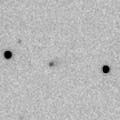
|
It reached to 16 mag in early 2006. Now it is 17.7 mag (Feb. 3, Ken-ichi Kadota). It will be fading very slowly from 17 mag to 18 mag until summer. In the Northern Hemisphere, it keeps locating high.
Date(TT) R.A. (2000) Decl. Delta r Elong. m1 Best Time(A, h)
Apr. 21 13 58.91 34 11.2 5.222 5.966 134 17.5 0:06 ( 0, 89)
Apr. 28 13 54.94 33 52.5 5.276 5.995 131 17.6 23:30 ( 0, 89)
|

|
It will be observable at 14 mag in good condition in 2008 spring. Now it is still faint as 18 mag, and getting lower in the evening sky after this. But it will appear in the morning sky again at 16.5 mag in October. Then it keeps observable in good condition until 2008 summer.
Date(TT) R.A. (2000) Decl. Delta r Elong. m1 Best Time(A, h)
Apr. 21 9 14.11 41 25.9 5.202 5.416 96 17.6 20:06 (127, 78)
Apr. 28 9 14.79 40 42.8 5.253 5.367 91 17.6 20:14 (115, 73)
|
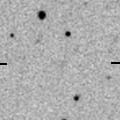
|
Now it is 18 mag. It will approach down to 0.4 A.U. to the sun in late October, and it is expected to reach to 6 mag. However, the condition in the Northern Hemisphere is very hard. It will be getting lower in the evening sky after this. The altitude becomes lower than 20 degree in early July, and lower than 10 degree in late July. The comet is still faint as 15.5 mag at that time. After conjunction with the sun, the comet will be brighter than 11 mag in late September, and will be 8 mag in mid October. But it locates extremely low, slightly over the horizon in the morning sky. It goes to the southern sky in late October, then it will never be observable again. In the Southern Hemisphere, it becomes unobservable in July. But it will appear in the evening sky at 7.5 mag in mid November. Then it keeps observable while fading gradually, although it will not locate very high.
Date(TT) R.A. (2000) Decl. Delta r Elong. m1 Best Time(A, h)
Apr. 21 10 35.88 26 17.0 2.686 3.291 118 17.8 20:39 ( 0, 81)
Apr. 28 10 27.64 27 5.5 2.710 3.203 110 17.7 20:14 ( 18, 82)
|
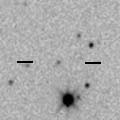
|
Now it is 18.2 mag (Mar. 14, Ken-ichi Kadota). It keeps observable in the evening sky at 17.5 mag until autumn when it becomes fainter than 18 mag, although the altitude will be getting lower after May.
Date(TT) R.A. (2000) Decl. Delta r Elong. m1 Best Time(A, h)
Apr. 21 10 16.36 17 56.3 1.158 1.864 118 17.8 20:20 ( 0, 73)
Apr. 28 10 19.58 18 7.7 1.186 1.828 112 17.8 20:14 ( 15, 73)
|
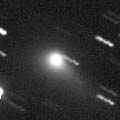
|
It has already faded down to 16.9 mag (Mar. 7, Ken-ichi Kadota). It will be fainter than 18 mag soon.
Date(TT) R.A. (2000) Decl. Delta r Elong. m1 Best Time(A, h)
Apr. 21 9 4.74 24 55.2 4.810 5.095 100 17.9 20:06 ( 55, 74)
Apr. 28 9 5.99 24 31.0 4.982 5.159 94 18.0 20:14 ( 68, 67)
|

|
Peculiar asteroid moving along a cometary orbit. It will approach to Sun down to 0.6 A.U. in late April. Then it will pass very near by Earth in May. The condition to observe it is very bad. Nobody can observe it until late May in the Northern Hemisphere. In the Southern Hemisphere, it will be observable in the morning low sky from late April to mid May. It will be 18.5 mag at best if it keeps asteroidal. However, if it shows cometary activity, it may be observed at 12-14 mag in the Southern Hemisphere. Then it may be visible visually at 11 mag in the evening sky in late May also in the Northern Hemisphere.
Date(TT) R.A. (2000) Decl. Delta r Elong. m1 Best Time(A, h)
Apr. 21 0 41.41 -9 12.1 1.296 0.615 27 18.3 3:51 (270,-17)
Apr. 28 0 46.08 -10 14.9 1.046 0.593 33 18.4 3:41 (272,-15)
|
|
![]()
 C/2006 M4 ( SWAN )
C/2006 M4 ( SWAN ) 4P/Faye
4P/Faye C/2006 K4 ( NEAT )
C/2006 K4 ( NEAT ) C/2006 V1 ( Catalina )
C/2006 V1 ( Catalina ) P/2006 HR30 ( Siding Spring )
P/2006 HR30 ( Siding Spring ) C/2002 VQ94 ( LINEAR )
C/2002 VQ94 ( LINEAR ) 99P/Kowal 1
99P/Kowal 1 C/2005 S4 ( McNaught )
C/2005 S4 ( McNaught ) 87P/Bus
87P/Bus C/2007 G1 ( LINEAR )
C/2007 G1 ( LINEAR ) C/2004 B1 ( LINEAR )
C/2004 B1 ( LINEAR ) C/2004 D1 ( NEAT )
C/2004 D1 ( NEAT ) C/2007 B2 ( Skiff )
C/2007 B2 ( Skiff ) C/2007 F1 ( LONEOS )
C/2007 F1 ( LONEOS ) 125P/Spacewatch
125P/Spacewatch C/2005 E2 ( McNaught )
C/2005 E2 ( McNaught ) 2006 WD4
2006 WD4![]()

























